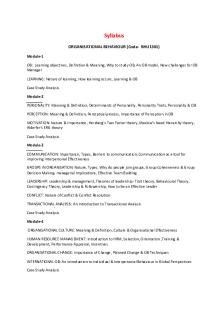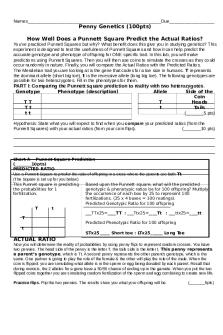Mendalin Genetics - full notes PDF

| Title | Mendalin Genetics - full notes |
|---|---|
| Author | jack ayy |
| Course | General Biology I |
| Institution | Rutgers University |
| Pages | 13 |
| File Size | 657.6 KB |
| File Type | |
| Total Downloads | 85 |
| Total Views | 159 |
Summary
full notes...
Description
Mendalin Genetics Ch 12.1 - 12.3 I. Mendels experimental approach >SEQ mendels work >CC blending & particulate inheritance >CC Components of mendels model II. Genetic crosses >SEQ, CC, APPLY monohybrid & dihybrid crosses III. Probability in genetics >apply rules to solve genetics problems I. Mendels Experimental approach A. Background Greger Mendel (1822-1884) Austrian monk 1st to discover basic rules of inheritance in eukaryotes Published 1865 Rediscovered in 1900 Foundation of science of genetics 2. Experimental organism - Garden pea - Pisum sativum Advantages A. inexpensive easy to grow B. many varieties C. short generation time, many offspring D. Clearly identifiable traits E. Easy to control pollination I. Stamen (male) & Carpel (female) II in nature > Self pollination Pollen grains released from stamens & land on carpel of same flower III. Experiemntally > Cross pollination Remove stamens before mature pollen produced > prevent self fertilization transfer pollen from different flower to carpel 3. Characteristics used by Mendel A. specific inherited property B. Trait > Variant C. 7 contrasting pairs
4. Applied quantitative methods A. experimental approach Planned experiments Recorded data B. Mathematical analysis of results 1st to use quantitative methods to study inheritance 5. Developed true breeding lines A. generations of self-fertilization > express same trait B. all individuals of line express same phenotype Appearance measurable attributes Expression of genes B.Tested blending inheritance hypothesis 1. Idea at mendel's time A. sperm and egg contains fluids from body >blend to form offspring B. problems Populations dont become uniform Traits skip generations 2. Mendel crossed true-breeding plants with contrasting traits P = parental generation F1 = first gen F2 = 2nd gen
C. particulate inheritance hypothesis Each characteristic controlled by 2 factors Heritable
Factor from one parent masks expression of factor from other parent Explains 3:1 inheritance pattern in F2 *now know heritable factors are genes* 4 components of mendel's model 1. Alleles Alternative versions of genes At same locus on homologous, but vary slightly in nucleotide seq
2. For each characteristic, individual inherits 2 alleles One from each parent Two alleles may be Identical (true-breeding lines) Or different Genotype = set of alleles Homozygous = 2 identical alleles at locus Homozygous dominant (BB) Homozygous recessive (bb) Heterozygous = 2 different alleles at locus (Bb) 3. If alleles at locus are different Determines organisms appearance Recessive allele Has no noticeable effect 4. Two principles of heredity Mendels laws of inheritance A. Law of segregation The 2 alleles for a heritable characteristic segregate during gamete formation and end up in different games. I. if organism has identical alleles for particular characteristic then allele present in all gametes
Ii. if different alleles present then ½ of gametes get one allele & other ½ of gametes get other allele
B. law of independent assortment
Two or more genes assort independently during gamete formation >each pair of alleles segregates independently of all other alleles Genetic variation
Independent assortment + crossing over = lots of genetic variation II. genetic crosses A. Introduction Make & test predictions 1. When you do a cross you * determine possible gametes in each parent *determine each possible genotype in off spring (every combination of parent alleles) *calculate the frequency of each possible genotype *illustrate mendel's laws 2. Punnett square Predicts allele composition of offspring from cross of individuals of known genotype
Ex. Parent 1 genotype = Bb Parent 2 genotype = Bb
B. Monohybrid cross 1. How mendel derived law of segregation Follows a single characteristic
2. Key points
PParents True-bredding (known genotypes) All offspring will be identical f1 Phenotype = dominant Genotype = heterozygous > monohybrids Gametes = ½ Y * ½ Y Not true breeding F2 Phenotype 3 dominant : 1 recessive Genotype 1 homozygous dominant 2. Heterozygous 1.Homozygous recessive Phenotype = observable Genotype = not observable 3. Test cross Identify genotype of dominant phenotype Dominant phenotype (homozygous dominant genotype or heterozygous genotype) X Recessive phenotype (Homozygous recessive genotype)
C. Dihybrid cross 1. How mendel derived law of independent assortment follows 2 characteristics 2. Key points Parents True breeding All offspring will be identical F1 Phenotype = dominant Genotype = Heterozygous at both loci > Dihybrids Gametes = ¼ YR, ¼ YR, ¼ yR & ¼ yr F2 Dihybrid phenotypic ratio of 9:3:3:1 Only works if alleles are on different pairs of homologs
3. Test cross Determine genotype of dominant phenotype Ex. AABB or AaBb Mate with homozygous recessive at both loci aabb Basis for law of segregation & law of independent assortment is in meiosis
III. Probability in genetics Laws of segregation & independent assortment reflect basic rules of probability Probability of an event = expected frequency Event is certain not to occur > probability = 0 Event is certain to occur > probability = 1 Expressed as fractions, decimal fractions, percentages Solve genetics problems with a punnett square Segregation of alleles and fertilization as chance events
A. Multiplication rule for independent events Predicts combined probabilities of independent events Occurrences of one event does not affect probability that the other event will occur Probability of having two or more independent events occur stated as P(this) and P(that) (multiply separate probabilities) Ex: What is the probability that two heterozygous parents will have a child that is homozygous recessive? Parent genotypes? Bb & Bb Parent gametes? ½ B & ½ b ½ B & ½ b Offspring genotype? bb P(bb) = P(b from mom) and P(b from dad) ½x½=¼ B. Addition rule for mutually exclusive events Predicts combined probabilities of mutually exclusive events Events cannot occur simultaneously > if one event happens, the other cannot P(this) or P(that) What is probability that two heterozygous parents will have a child that is homozygous dom or homozygous rec?
Parent genotypes? Bb & Bb Parent gamtes? ½ B & ½ b ½ B & ½ b Offspring genotype BB or bb P(BB) or P(bb) ½*½+½*½=¼+¼=½ More than one allele Ex. Mom is AaBB and dad is AABb what is probability they produce child who is AABb? Parent gametes? Mom = ½ A and ½ a Dad = A ½ B and ½ b P(AABb) = P(AA) and P(Bb) ½ * 1 * 1*½ = ¼...
Similar Free PDFs

Mendalin Genetics - full notes
- 13 Pages

Genetics Notes
- 3 Pages

FULL Notes
- 229 Pages

Full notes
- 102 Pages

Genetics - Lecture notes 8
- 7 Pages

Topic 3 Notes - Genetics
- 27 Pages

Unit 2 - Genetics - Notes
- 22 Pages

Genetics Exam1 Pt2 Notes
- 12 Pages

Genetics Notes - 30600
- 20 Pages

Bio261 (genetics) final notes
- 45 Pages

Genetics Penny Genetics
- 4 Pages

Genetics Notes (Exam 1) Summary
- 68 Pages

Bacterial Genetics - Lecture notes 5
- 17 Pages
Popular Institutions
- Tinajero National High School - Annex
- Politeknik Caltex Riau
- Yokohama City University
- SGT University
- University of Al-Qadisiyah
- Divine Word College of Vigan
- Techniek College Rotterdam
- Universidade de Santiago
- Universiti Teknologi MARA Cawangan Johor Kampus Pasir Gudang
- Poltekkes Kemenkes Yogyakarta
- Baguio City National High School
- Colegio san marcos
- preparatoria uno
- Centro de Bachillerato Tecnológico Industrial y de Servicios No. 107
- Dalian Maritime University
- Quang Trung Secondary School
- Colegio Tecnológico en Informática
- Corporación Regional de Educación Superior
- Grupo CEDVA
- Dar Al Uloom University
- Centro de Estudios Preuniversitarios de la Universidad Nacional de Ingeniería
- 上智大学
- Aakash International School, Nuna Majara
- San Felipe Neri Catholic School
- Kang Chiao International School - New Taipei City
- Misamis Occidental National High School
- Institución Educativa Escuela Normal Juan Ladrilleros
- Kolehiyo ng Pantukan
- Batanes State College
- Instituto Continental
- Sekolah Menengah Kejuruan Kesehatan Kaltara (Tarakan)
- Colegio de La Inmaculada Concepcion - Cebu


